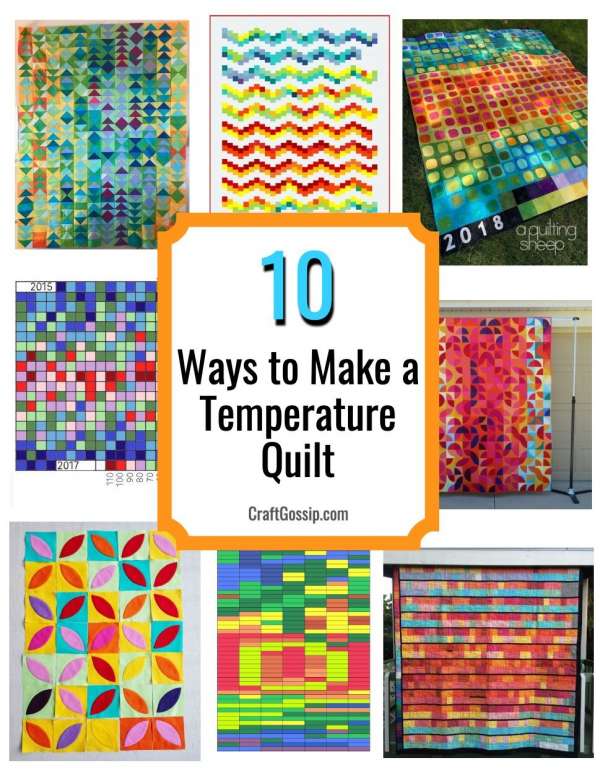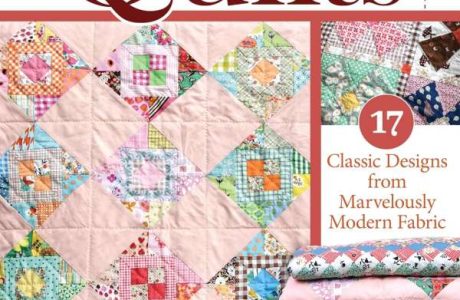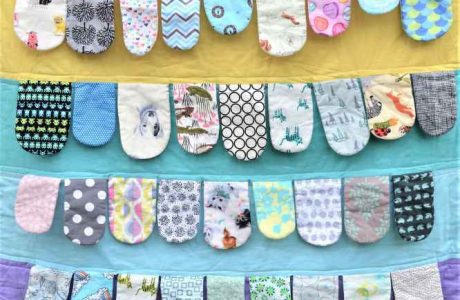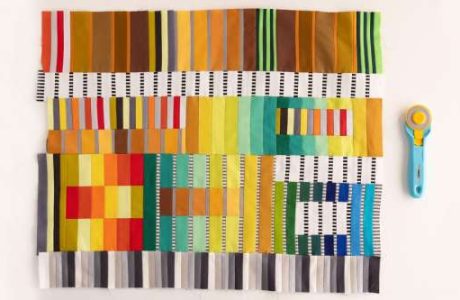
Have you ever wanted to make a temperature quilt? Are you familiar with what one is? Temperature quilts are kind of like a daily diary of the temperatures that occurred throughout the year in a particular place. Of course this diary is written with fabric and color, not words. They are lots of fun to make, but they do take some planning and dedication.
Making your own temperature quilt can be a fun and creative way to track the weather and the changing seasons. A temperature quilt is a type of quilt that uses different colors or patterns to represent different temperature ranges. For example, you might use blue fabric to represent cold temperatures, green fabric to represent moderate temperatures, and red fabric to represent hot temperatures.
To make a temperature quilt, you will need a variety of fabric in different colors or patterns, a sewing machine, and basic quilting supplies such as scissors, needles, and thread. You can choose to use solid-colored fabric or print fabric with patterns or designs that represent different temperatures.
To create your quilt, you will first need to decide on the size of your quilt and the number of temperature ranges you want to include. You can then cut your fabric into squares or rectangles that represent each temperature range. You can also choose to add additional elements to your quilt, such as appliquéd weather symbols or embroidered phrases.
Once you have all of your fabric pieces cut out, you can begin piecing them together using a sewing machine or by hand. You can arrange the fabric squares or rectangles in a variety of patterns, such as a gradient from cold to hot or a checkerboard pattern with different temperatures alternating.
Once your quilt top is pieced together, you will need to add a backing, batting, and quilting. Quilting is the process of stitching the layers of the quilt together to hold them in place and create a cohesive finished product. You can choose to do the quilting by hand or use a sewing machine to create a variety of quilting patterns.
Overall, making a temperature quilt is a fun and creative way to track the weather and the changing seasons. It is also a great way to learn basic quilting techniques and create a unique and personal piece of home decor.
The best thing about a temperature quilt is that each one is unique. As you will see, quilters use all kinds of designs for their layouts. Here are 10 ideas to get you started on yours.
- How and Why to Make a Temperature Quilt by Darcy Quilts
- How to Make a Temperature Quilt by Elm Street Quilts
- Average Daily Temperature Quilt by The Kim Six Fix
- Temperature Quilt 2020 by Canuck Quilter Designs
- Temperature Quilt 2020 by The Twiddletails Blog
- Temperature Quilt Finish by Flourishing Palms
- 2018 Temperature Quilt by A Quilting Sheep
- Orange Peel Temperature Quilt by Samelia’s Mum
- Temperature Quilt Top by Occasional Piece Quilt
- Tale of Two Cities Temperature Quilt by Live a Colorful Life
For even more temperature quilt fun, make sure to check out the follow up article: 10 More Ways to Make a Temperature Quilt
Make sure to check them all out because each design is completely unique and you will get plenty of inspiration.
The amount of time it takes to make a temperature quilt will depend on a variety of factors, including the size of the quilt, the complexity of the design, and your personal skill level. Some other factors that can affect the time it takes to make a temperature quilt include the type of fabric you choose, the type of quilting you choose, and whether you are making the quilt by hand or using a sewing machine.
In general, it is possible to make a small temperature quilt in a few days or a week if you are working on it consistently. A larger or more complex quilt may take longer, potentially several weeks or even months to complete.
It is also worth noting that the time it takes to make a temperature quilt will depend on your personal sewing skills and experience. If you are a beginner, it may take you longer to complete the quilt, as you will need to learn the necessary skills and techniques as you go. If you are an experienced quilter, you may be able to work more quickly and efficiently.
Overall, the time it takes to make a temperature quilt will vary depending on a variety of factors. It is a good idea to plan ahead and allow yourself plenty of time to complete your quilt, especially if you are a beginner or if you are making a larger or more complex quilt.
Quilting is about so much more than making pretty patterns on your bed. Making a quilt to give as a keepsake is the most common use of this craft, and it’s also one of the easiest. Make a quilt in just a few steps, and you’re done! If you make one for others, be sure to choose a quilt pattern that will look nice on an everyday bed rather than something ornate for a guest room. Here are some helpful tips for creating the perfect keepsake quilt:










I love quilts. Thank you.